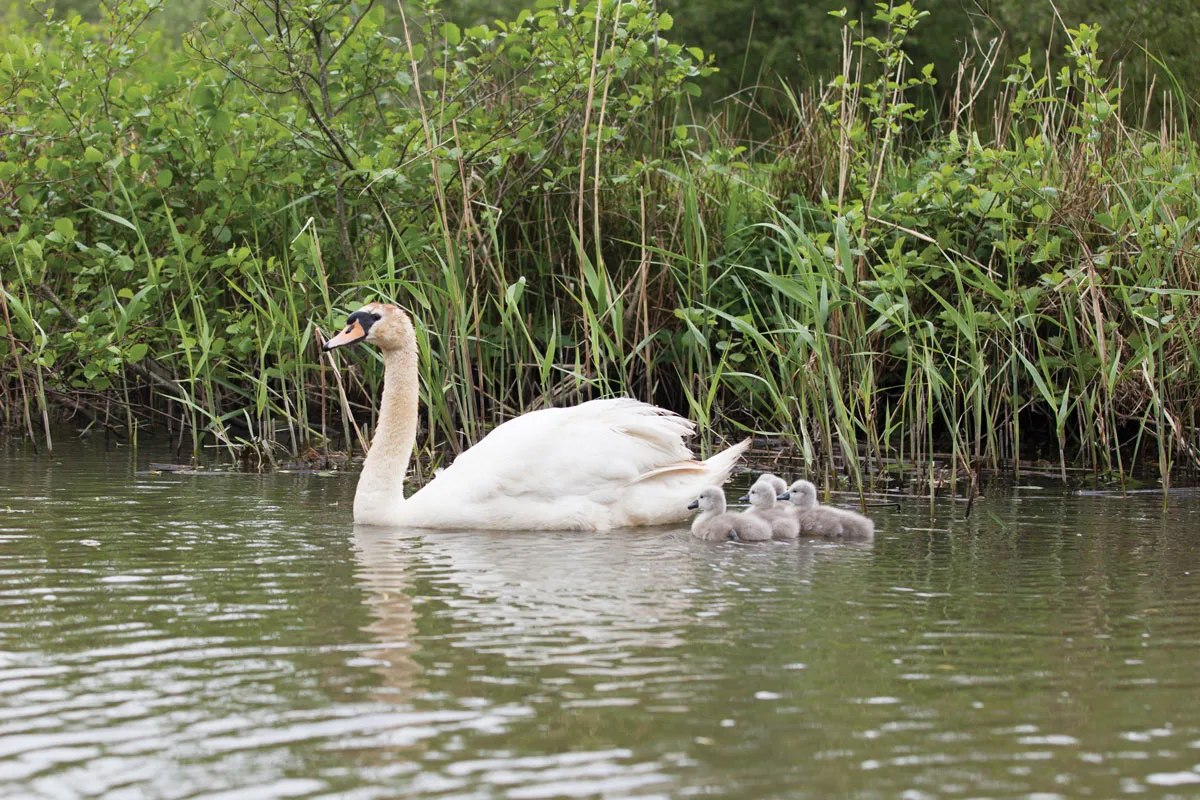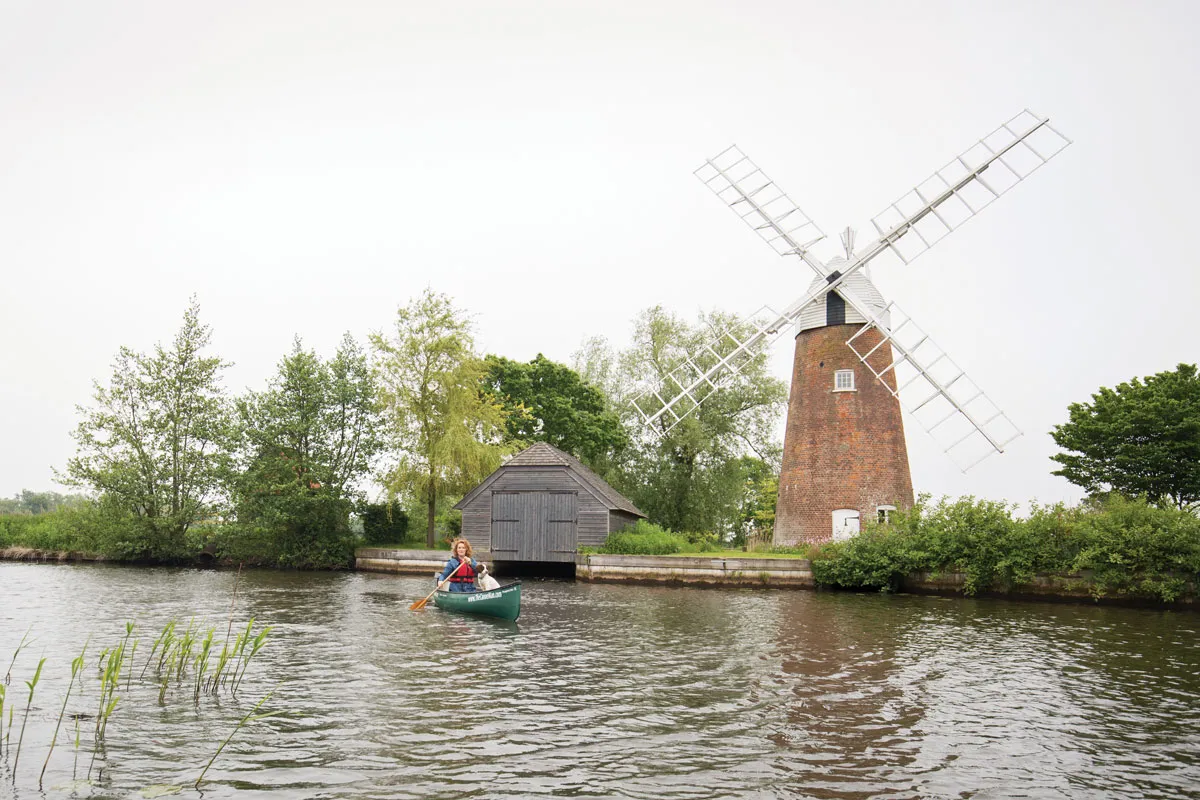Since moving to East Anglia a few years ago, I have discovered a watery wildlife haven, right on my doorstep – the Broads. Ranging over 117 square miles of Norfolk and Suffolk, this is Britain’s largest nationally protected wetland, and home to more than a quarter of the rarest plants and animals in the UK.
A unique patchwork of rivers and lakes, the Broads is not – as was once thought – a natural landscape, but a result of intensive peat digging in the Middle Ages to provide fuel. The empty pits flooded, forming lakes known locally as broads. When combined with the area’s natural rivers, they make up a network of more than 125 miles of navigable waterways, nowadays mainly used for recreation. The area is famed for its wind and drainage mills, which add to the distinctive scenery.
I usually take my young family every summer on our little wooden boat, gently motoring up the rivers to sail on the open Broads. One of my favourite routes is to launch on to the River Thurne, pass by the monastic ruins of St Benet’s Abbey, founded by Benedictine monks in 1020, then gently pootle up the River Ant past How Hill Nature Reserve. You’ll see a good selection of the picturesque drainage mills along the way, and then carry on up to Barton Broad.
It’s beautiful, but can get very busy in holiday times, so for this trip I decided to get away from it all while getting closer to the wildlife by exploring parts I hadn’t been to before. To do so, I took a guided canoe trip with Mark Wilkinson, aka The Canoe Man, on one of the quietest and more remote stretches of water in the Norfolk Broads.
Tranquil travel
Our day begins at Honing lock, on the disused North Walsham and Dilham canal, which joins the far reaches of the River Ant. We put our
14ft (4.3m) Canadian canoe into about four inches of shallow water and start to paddle our way slowly, using the single-handed paddle, through the first narrow stretch, brushing against the reeds on either side as we go.
As the water widens and deepens, paddling becomes a bit easier and we are able to take in the distinct flora and fauna of the region. On what was once a busy canal with boats ferrying cargo back and forth to the port of Great Yarmouth, now it is only us.
One advantage of travelling by canoe is that these vessels give you exclusive access to stretches of gin-clear rivers that are virtually free of traffic. No other motor craft can get here, so even if you do see another canoe, you have the place to yourselves, with only cows grazing on the banks and the nonchalant swans for company.

As we paddle, all around us the birds are chorusing: sedge and reed warblers and even a shrill call from the rare Cetti’s warbler. A gangly grey heron takes off just as we round the bend and swallows swoop closely in front of us, as whirlygig beetles whizz about on the surface, usefully munching on gnat larvae (the ones that bite you as adults).
Paddling along, I can see huge flat water lily leaves just under the surface and bright yellow flag irises paint the landscape. Bullrushes are nodding in the breeze above our heads as we drift downstream, joining the faster-flowing River Ant, keenly on the look-out for a speedy blue flash of a kingfisher, or the ploppy roll of an otter’s tail in the water. Ancient alder trees give an almost eerie silhouette against the wide sky and willows droop over the banks as we meander along.
Snaking along
Mark is very knowledgeable about the area and the wildlife, so much so, that when a swimming grass snake comes towards us, he swiftly but gently grabs it from the water and shows it to me first-hand – a wildlife experience I won’t forget!
About an hour’s paddle downstream we come to the Wayford Bridge Inn. The only hostelry on the route, it’s a good place to stop for some refreshment, or to moor up and find a peaceful spot on the riverbank for a picnic. Here we have our first encounter with large motor boats, so you need to stay on the right and hug the bank as they cruise past. The boats push through the water and create a wave behind them, known as the ‘wash’ – be ready for it, point your bows across the wave, and you should be fine.

Another hour down the River Ant takes us past one of the most iconic windmills, Hunsett Mill, right on the water. As we stop for a photo opportunity, another Broads icon, a spectacular marsh harrier, flies right over our heads.
Into the open water
Carrying on downriver, the tour finally takes me to Barton Broad, where none other than Norfolk’s Lord Nelson learned to sail as a boy. Its vast expanse of open water is great for sailing but it can get choppy, so canoeists tend to venture round the edge, exploring the quiet staithes off the broad. The Ant Broads and Marshes National Nature Reserve is here and a final secret place (one of Mark’s top tips) is to moor up at Wood End Staithe, where you can walk into Great Fen, which is a butterfly haven in the summer months.
It’s lovely to share my canoe with Suka – the sprightly young sprocker spaniel sometimes making paddling a bit awkward, but is a delight all the same. There is so much to see and explore that even a day trip feels as though you’ve been to a different world, where you can switch off completely. As you are paddling, the trip is as silent as you want it be, with just the sounds of nature around you, engine-free.
We finish at the picturesque marina of Barton Turf. From there, if you make an arrangement with a canoe provider like Mark, you’ll get driven back to Wroxham. This is a one-way day trip that covers quite a good distance, with an abundance of wildlife and ever-changing scenery. Another recommended quiet canoe route is from the top of the River Bure, from Aylsham to Coltishall, which is great for wild camping and more intrepid expeditions.
I end the day relaxed and invigorated, looking forward to another trip soon, to hopefully spot those elusive otters, kingfishers and swallowtail butterflies next time.
More information
To undertake a similar expedition, contact The Canoe Man (0845 4969177, www.thecanoeman.com). Canoes, kayaks and paddleboards can be hired all over the area. Find out more at www.canoethebroads.co.uk
Shauna Lowry is a presenter on Countryfile. Previous credits include The One Show, One Man and His Dog, Treasure and Animal Hospital. She is a fully qualified scuba diver and proficient horse rider, as well as a keen wildlife photographer.